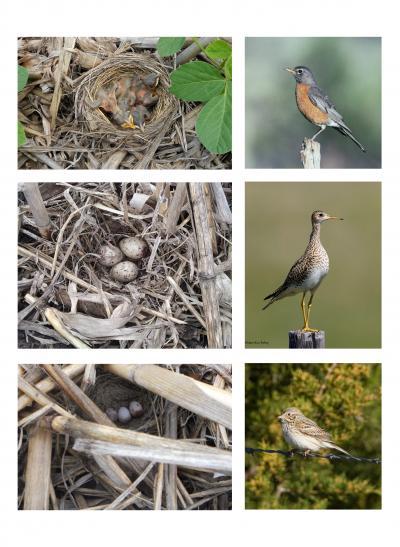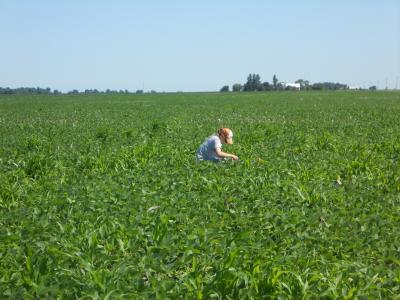While marketing campaigns against farming claim otherwise, agricultural practices can have a broad beneficial influence on bird abundance and diversity. Row crops are considered to be bad for wildlife but a new study shows that isn't necessarily true.
The report finds that several bird species – some of them rare – are making extensive use of soybean fields in Illinois.
The team spent about 13 weeks each spring and summer in 2011 and 2012 scouring a total of 24 fields (12 per year) in two counties in Central Illinois. The fields were 18 to 20 hectares (44-49 acres) on average, and the researchers walked roughly 3,200 kilometers (1,988 miles) in the course of the study.
The team found more bird nests and greater species diversity in the no-till fields than in the tilled soybeans. Nest losses were high, however. About 80 percent of nests in the no-till fields and more than 90 percent in tilled fields failed as a result of predation or the onset of farm operations before eggs hatched or young birds were ready to fly.
High mortality is fairly common in bird nests, however, and while the losses in no-till soybean fields were greater than those seen in pristine grasslands, they were not much worse, the researchers said.
"I was surprised to see all the different birds that are using these agricultural fields – especially during spring migration," said Kelly VanBeek, a wildlife biologist at the Wisconsin Department of Natural Resources who conducted the study while a graduate student at the University of Illinois at Urbana-Champaign. "I was shocked by the variety of sparrow species that we saw – white-crowned sparrows and white-throated sparrows, for example."

American robins (top) and vesper sparrows (bottom) were found nesting in greater abundance in no-till than in tilled soybean fields. A rare grassland species, the upland sandpiper (center) was found nesting in a no-till field. Photo of nests: Kelly VanBeek; Photo of robin: US Fish&Wildlife Service; Photos of sandpiper and sparrow: Mary Kay Rubey.
Some of the birds using no-till fields are grassland species that have been in decline across the Midwest for decades, said Michael Ward, a professor of natural resources and environmental sciences at Illinois and an author of the study. One species found nesting in a no-till soybean field, the upland sandpiper, was an exciting find.
"The upland sandpiper is a state-endangered species. It's doing badly throughout its range," Ward said. "Historically, it probably followed bison herds and liked really short grass, but we don't have that anymore. We found that it's going to these no-till fields where the herbaceous cover early in the year is not that thick – which is what it likes – and we actually found a nest."
"Generally row crops are not good for wildlife," said University of Illinois at Urbana-Champaign professor Jeffrey Brawn, a co-author of the study. "They're just not. But this paper shows that in situ agricultural production – depending on how you do it – can have some benefits for wildlife."
The team also found other grassland species that are in decline – Eastern meadowlarks, ring-necked pheasants and field sparrows – nesting in no-till fields.
"If you look at birds in general or wildlife in general, the ones that did occupy grassland habitat are the ones whose populations have tanked the most," Brawn said. "But birds are very resilient, they're very resourceful and they're very flexible, and we can take advantage of that."
Of the nests that failed, 65.1 percent were raided by predators and 24.4 percent were lost to farm machinery during crop planting. Continuously recording cameras trained on nests showed that coyotes were the primary predators of the ground-level nests – another surprise.
"This just shows that we do have predators in these landscapes, which is a good thing," VanBeek said. "Several decades ago, we didn't have coyotes here; we had completely lost those predator species that bring some ecological balance. We may not be in a balanced situation yet, but at least they're present."
The study points to a major opportunity for bird conservation, Ward said. Rather than buying up modest tracts of land for wildlife preservation, an approach that is minimally effective, he said, farmers and conservationists could work together to maximize the ecological role that no-till lands are already playing in the Midwest.

Kelly VanBeek discovered that no-till soybean fields are contributing more to bird diversity, survival and nesting success than previously appreciated. Credit: Kelly VanBeek
If farmers could be convinced to plant their soybeans a few days later in the spring, for example, it would increase the nesting success of several bird species that are out there now, Ward said. A pilot program in Indiana is testing this approach, compensating farmers for losses that stem from the planting delay, he said.
"There's so much land in agriculture that if only 3 or 4 percent of farmers adopted this approach, it would have a greater effect than all the land that we have in wildlife preserves in Illinois," he said.
According to the U.S. Department of Agriculture, in 2009 (the most recent year for which data are available) 35.5 percent of U.S. cropland, some 88 million acres, were in no-till production.
"Most people, they drive past corn and soybean fields in Illinois and they say there's no way there's value for wildlife in those," VanBeek said. "But we've proved there is. These agricultural fields are not ecological wastelands. There's some value there."
Source: University of Illinois at Urbana-Champaign




Comments